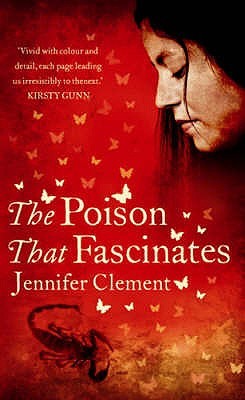Woman, divine woman, you have the poison that fascinates in your eyes, goes the song by Augustin Lara from which Jennifer Clement takes the title to her second novel, The Poison That Fascinates (2008), and it’s a more than apt reference point for a novel full of intriguing women who have, at their core, something toxic. Veteran of a number of previous poetry collections, Clement brings a lyrical treatment to prose that evokes the Mexico of the setting, the Mexico in which she’s resident, the Mexico she knows so well and no doubt loves.
Emily Neale lives with her father in Mexico City, her mother having abandoned them years before. They are collectors of sorts, her collecting strange facts, notably newspaper cutouts of womens’ nefarious deeds, typically murders; him gathering his lists of Mexico City’s lost things (“trolley cars, pepper trees, garter snakes, rivers and lakes, bats, and the forests”) – truly they are an odd pairing.
Beyond their unusual interests, however, there’s their benevolent side. Emily’s great-grandmother founded the Rosa of Lima Orphanage to which Emily devotes her time, giving her a strange connection to the children living there since “they think she is half of what they are…as if being left with one parent were somehow impossible”. Running the orphanage now is Mother Agata, a woman so large “a man could get lost in her arms” and to the orphans “is a tree, a wall, and a church that casts shade.” Agata provides Emily with her extensive hagiographic knowledge – recalling saints, their feast days, and their patronage – and her more morbid press clippings of murderesses, which include the infamous – Lizzie Borden, Belle Gunness, Báthory Erzsébet – amongst lesser known names.
Coupled with the narrative are a series of italicised interpretations of these press clippings, in which the prose sometime reaches its most poetic, such as this example describing Lucrezia Borgia’s hair:
Her hair is wheat-hair to be eaten, desert-coloured to be cocooned inside, straw-hair that suffocates and leaves an elbow, ribbon of thigh, light moon moments of skin exposed out of the tangled thicket…
…In her black, stone-black, fairytale-black tower, she watches the white sails of sailboats move, and lilt and sway and swing, like empty wedding dresses.
The joy of these passages are that, like Emily and her orphans, there’s a sufficient distance between them and the main narrative, that is until both paths come together in a satisfactory and pleasing manner. The treatment, too, is enjoyable as rarely do these passages cover the same ground stylistically, even when Clement is describing poisons, or making poetry of imagined ailments and superstitions.
Of course, living in a fantasy world of murderers and saints, Emily’s connection to the world at large is scant and it’s only with the arrival of her enigmatic cousin, Santiago, that she begins to come terms with who she is:
‘Emily, you’re not living inside a book any more. You thought the woods were green and the ocean was blue., but they aren’t. You were happy in those books, buy you’re outside now and you are not walking on paper…’
While the novel deals with the lives of its people in the here and now, the relationship between Emily and Santiago recalls Mexican history, a scene at the Pyramid of the Sun at Teotihuácan perhaps, like Emily’s birthday being Saint Rita’s feast day (“the saint evoked against bleeding and desperate situations”), hinting at a subversion of the Aztec Quetzalcoatl myth discussed there.
With The Poison That Fascinates being set in Mexico City, there’s little of the city at large, allowing Clement to focus on her small party of characters and work only with a few choice locations, and this non-populous instance of the city, along with the poetic prose, lends the novel a certain Latin Gothic tone that gives the feeling of enclosure with the characters rather than observers passing through:
In Mexico City the sky is brown smoke. The sky is yellow smoke. The sky is green smoke. The sky no longer belongs to heaven. It is not a sky. It is a ceiling.
Working as a fable, The Poison That Fascinates entwines well the lives of saints and sinners, the past and present, spinning in a dark thread of Catholic themes to pattern an enjoyable novel showing the extremes of womanhood, leading to tragic circumstances. As Emily knows, “the weapons of women are in teacups, sinks, cabinets and thimbles – places where poison can be hidden”; as Augustin Lara knows, it’s in their eyes.

You like the word ‘nefarious’ then? 😉
I do believe you just made a ‘fantasy’ genre novel sound almost worth a read. I will buy this anyway, because the cover is just stunning!
Oh, it’s not a fantasy novel, steffee. It’s a novel set in present day Mexico that, due to a terse interpretation of prose poetry, gives it an ethereal quality that makes it feel like a fable. It’s not though.
Oh, okay. That borders too much on the ‘fantasy’ side by my definitions, though – strictly realism, y’know.